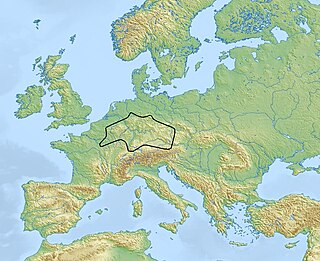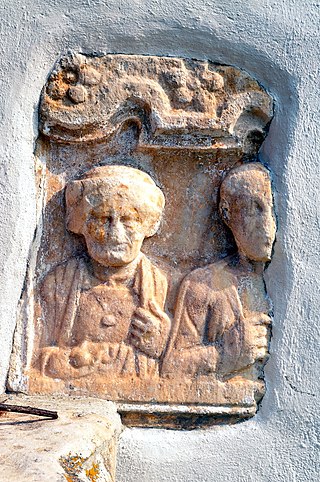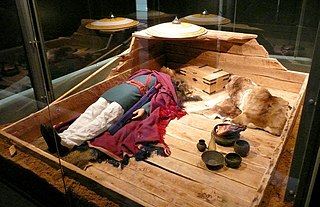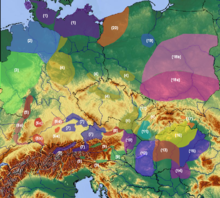
The Únětice culture, Aunjetitz culture or Unetician culture is an archaeological culture at the start of the Central European Bronze Age, dated roughly to about 2300–1600 BC. The eponymous site for this culture, the village of Únětice, is located in the central Czech Republic, northwest of Prague. There are about 1,400 documented Únětice culture sites in the Czech Republic and Slovakia, 550 sites in Poland, and, in Germany, about 500 sites and loose finds locations. The Únětice culture is also known from north-eastern Austria, and from western Ukraine.

The Baalberge Group was a late neolithic "culture" in Central Germany and Bohemia between 4000 and 3150 BC. Because of issues with the archaeological use of the term culture it is now often referred to as the Baalberge Ceramic style. It is named after its first findspot: on the Schneiderberg at Baalberge, Salzlandkreis, Saxony-Anhalt. The Baalberge group is generally seen as part of the Funnelbeaker culture. In the Middle Elbe/Saale region it is part of Funnelbeaker phase TRB-MES II and III.
The Ottomány culture, also known as Otomani culture in Romania or Otomani-Füzesabony culture in Hungary, was an early Bronze Age culture in Central Europe named after the eponymous site near the village of Ottomány, today part of Sălacea, located in modern-day Bihor County, Romania. The Middle Bronze Age period of the Ottomány culture in eastern Hungary and western Romania is also known as the Gyulavarsánd culture.

Louis Kugelmann, or Ludwig Kugelmann, was a German gynecologist, social democratic thinker and activist, and confidant of Marx and Engels.
The Frankleben hoard is a significant hoard deposit of the European Bronze Age, associated with the Unstrut group (associated with the Tumulus or early Urnfield culture. The site is in the Geisel valley, formed by a minor tributary of the Saale River. It was discovered in 1946 in a brown coal pit near Frankleben, now a part of Braunsbedra municipality, Saxony-Anhalt, Germany.

The Michelsberg culture is an important Neolithic culture in Central Europe. Its dates are c. 4400–3500 BC. Its conventional name is derived from that of an important excavated site on Michelsberg hill near Untergrombach, between Karlsruhe and Heidelberg (Baden-Württemberg), Germany.
The Wartberg culture, sometimes: Wartberg group (Wartberggruppe) or Collared bottle culture (Kragenflaschenkultur) is a prehistoric culture from 3,600 -2,800 BC of the later Central European Neolithic. It is named after its type site, the Wartberg, a hill near Niedenstein-Kirchberg in northern Hesse, Germany.

Heinrich Fink was a German theologian, university professor and politician. In 1991 Fink was dismissed from Humboldt University of Berlin due to allegations against him being a former informer for the East German state security office, the Stasi. Fink denied the allegations.

Marcus Junkelmann is a German historian and experimental archeologist.
Bernhard Maier is a German professor of religious studies, who publishes mainly on Celtic culture and religion.

The Eisbach, locally known as die Eis, is a 38-kilometre (24 mi) long river and left or western tributary of the Rhine in the northeastern Palatinate and southeastern Rhenish Hesse, in the German state of Rhineland-Palatinate.
Wolfram Hoepfner is a German classicist, archaeologist, architectural historian, and Professor of Ancient Architectural History, at the Free University of Berlin.
Hans Rupprecht Goette is a German classical archaeologist.
Roland Hagenbüchle was a scholar for American Studies and cultural philosopher.

The position of ancient Celtic women in their society cannot be determined with certainty due to the quality of the sources. On the one hand, great female Celts are known from mythology and history; on the other hand, their real status in the male-dominated Celtic tribal society was socially and legally constrained. Yet Celtic women were somewhat better placed in inheritance and marriage law than their Greek and Roman contemporaries.
Heiko Steuer is a German archaeologist, notable for his research into social and economic history in early Europe. He serves as co-editor of Germanische Altertumskunde Online.
The Hunsrück-Eifel Culture is an Iron Age cultural group of the Middle Rhine region of western Germany (Rhineland-Palatinate) and eastern Belgium and Luxembourg. The names "Hunsrück" and "Eifel" refer to a pair of low mountain ranges covering most of the region.
Matthias Untermann is a German art historian and medieval archaeologist.

The Kemathen warrior was a Germanic mercenary in the service of Rome who lived in the Limes foreland near the present-day German town of Kipfenberg and was honored in the Upper Bavarian district of Eichstätt. The individual grave, which was discovered in 1990, contained not only parts of the skeleton of the 30-year-old man, but also numerous grave goods that distinguish him as a Roman officer as well as a Barbarian chieftain. His skeleton and the grave finds, together with a faithful replica of the tomb, are in the Roman and Bavarian Museum in Kipfenberg.
Anja Hellmuth Kramberger, born Hellmuth is a German archaeologist, author and researcher.











